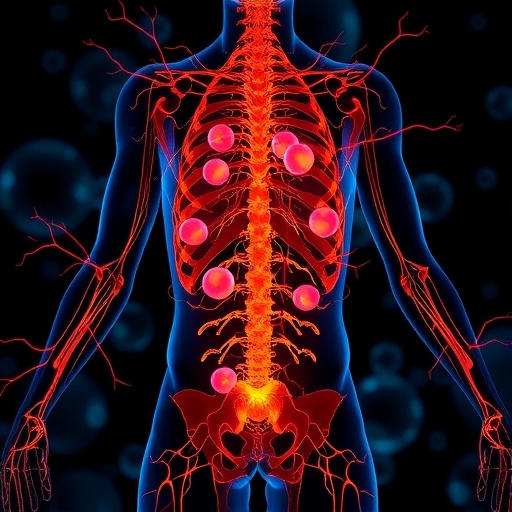
In a groundbreaking discovery that reshapes our understanding of metabolic regulation and neurobiology, researchers have unveiled a novel molecular mechanism through which brown adipose tissue (BAT) influences its own neural network. The study, recently published in Nature Communications, reveals that BAT secretes a protein known as OLFM4, orchestrating sensory and sympathetic nervous system innervation via Schwann cells—a finding that opens new vistas for therapeutic strategies targeting metabolic disorders and neurodegenerative diseases.
Brown adipose tissue, long celebrated for its unique capacity to dissipate energy as heat via non-shivering thermogenesis, has recently been implicated in complex cross-talk with the nervous system, but the molecular mediators of this dialogue remained elusive. The team led by Lai, Zhou, Zou, and colleagues has now identified OLFM4—a secreted glycoprotein—as a critical neuromodulatory agent released by brown fat cells, effectively bridging the gap between adipocytes and peripheral neural components.
The central nervous system coordinates systemic metabolism via sympathetic nervous system output, while sensory innervation provides feedback that influences adaptive thermogenesis. Prior work established that BAT is heavily innervated by sympathetic fibers, but the exact cellular and molecular mechanisms that guide the patterning and plasticity of these neural connections were poorly understood. This new research sheds light on the active role of adipose tissue, positioning BAT not merely as a passive recipient of neural signals but as an active participant that secretes factors instructing nerve growth and repair.
.adsslot_qro5TbWulQ{width:728px !important;height:90px !important;}
@media(max-width:1199px){ .adsslot_qro5TbWulQ{width:468px !important;height:60px !important;}
}
@media(max-width:767px){ .adsslot_qro5TbWulQ{width:320px !important;height:50px !important;}
}
ADVERTISEMENT
Of particular interest is the role of Schwann cells—the principal glia of the peripheral nervous system responsible for myelination, nerve regeneration, and trophic support of axons. The study illustrates that OLFM4 acts on Schwann cells, modulating their phenotypic behavior to facilitate the coordination of both sensory and sympathetic nerve fibers innervating brown fat. By influencing Schwann cell function, OLFM4 ensures a finely tuned neural network optimized for rapid and efficient metabolic control.
The molecular pathway elucidated involves OLFM4 binding to receptors on Schwann cells, triggering signaling cascades that promote Schwann cell migration, proliferation, and support of neural axon extension. This finding indicates a sophisticated biological dialogue wherein BAT-derived OLFM4 acts as a molecular beacon, directing peripheral nerve remodeling in response to metabolic demands. It implies that brown fat can adapt its innervation dynamically, potentially adjusting energy expenditure by remodeling its nervous inputs.
Moreover, the researchers employed a combination of advanced molecular biology techniques, in vivo imaging, and genetic manipulation to dissect this pathway with unprecedented resolution. Using mouse models with BAT-specific deletions of OLFM4, they demonstrated disrupted nerve patterning and impaired thermogenic response, confirming the functional importance of this secreted protein. Conversely, exogenous administration of OLFM4 in experimental settings enhanced nerve regrowth after injury, highlighting its therapeutic potential.
This discovery holds profound implications for conditions such as obesity, diabetes, and even neurodegenerative diseases where neural dysfunction and metabolic dysregulation intersect. Manipulating OLFM4 signaling could offer a novel approach to restoring sympathetic nerve balance in brown fat, thereby optimizing metabolic rates and improving systemic glucose homeostasis. Additionally, the Schwann cell-mediated mechanisms identified here may be repurposed to foster peripheral nerve regeneration in neuropathies.
Importantly, the study also challenges the classical view of adipose tissue biology by demonstrating that brown fat is not only an energy-burning organ but also a neurotrophic niche capable of instructing its own innervation. This opens avenues to explore other secreted factors from adipose depots and their roles in peripheral nervous system plasticity. It also raises intriguing questions about the developmental biology of BAT and its innervation patterns during aging and metabolic stress.
The discovery of OLFM4’s role in BAT innervation additionally intersects with emerging research on the gut-brain axis and systemic inflammation, given that OLFM4 has been previously implicated in immune modulation. This connection suggests a multifaceted role for OLFM4 that may integrate metabolic, neural, and immune signals to maintain homeostasis, particularly in states of environmental challenge such as cold exposure or dietary shifts.
Technological advances such as single-cell RNA sequencing enabled the researchers to map Schwann cell subpopulations affected by OLFM4, providing a granular understanding of cellular heterogeneity within the peripheral nervous system adjacent to BAT. This approach could serve as a model for future investigations into the cellular microenvironments that regulate peripheral nerve function and regeneration.
Furthermore, the study’s insights into sensory nerve modulation by OLFM4 highlight a bidirectional communication framework. Sensory neurons relay information regarding temperature, nutrient status, and adipose tissue health back to central circuits, influencing behavior and autonomic output. By coordinating both sensory and sympathetic fibers, OLFM4 ensures the integration of efferent and afferent signals required for precise metabolic regulation.
Potential translational applications abound from this research. Pharmaceutical agents that mimic or enhance OLFM4 activity could be developed to promote beneficial BAT innervation, thereby elevating metabolic rates without adverse cardiovascular effects. Conversely, antagonists of OLFM4 could modulate overactive sympathetic nerve signals contributing to hypertension or chronic stress responses.
The authors note that while OLFM4’s role in BAT is novel, related olfactomedin family proteins have been implicated in neural development and cancer biology, suggesting that OLFM4 may have diverse biological functions depending on tissue context. Future work could explore OLFM4’s interactions with other molecular partners and its systemic endocrine effects beyond the adipose tissue niche.
This pioneering study represents a leap forward in comprehending how peripheral tissues engage with their nervous system partners to coordinate complex physiological processes. It underscores the importance of cross-disciplinary approaches integrating neurobiology, metabolism, and cell biology to unravel intricate regulatory networks.
In summary, the identification of OLFM4 as a secreted factor by brown adipose tissue that orchestrates its own sensory and sympathetic innervation via Schwann cells reveals a novel layer of metabolic control with vast implications for our understanding of energy homeostasis and peripheral nerve biology. This discovery invites a reimagining of adipose tissue as an active neuroendocrine organ, one capable of dynamic adaptation through molecular dialogue with the nervous system. As research progresses, harnessing OLFM4’s capabilities may unlock new therapeutic pathways for metabolic diseases and nerve repair.
Subject of Research: Molecular mechanisms underlying the coordination of sensory and sympathetic innervation of brown adipose tissue mediated by OLFM4 signaling through Schwann cells.
Article Title: Brown adipose tissue secretes OLFM4 to coordinate sensory and sympathetic innervation via Schwann cells.
Article References:
Lai, M., Zhou, W., Zou, W. et al. Brown adipose tissue secretes OLFM4 to coordinate sensory and sympathetic innervation via Schwann cells. Nat Commun 16, 5206 (2025). https://doi.org/10.1038/s41467-025-60474-1
Image Credits: AI Generated
Tags: brown adipose tissuecross-talk between nervous system and adipose tissuemetabolic disorders treatment strategiesnerve cell guidance by brown fatneurobiology and metabolismneuromodulatory agents in fat cellsOLFM4 protein secretionSchwann cells and adipocytessensory innervation in thermoregulationsympathetic nervous system interactiontherapeutic implications for neurodegenerative diseasesthermogenesis and neural connection



